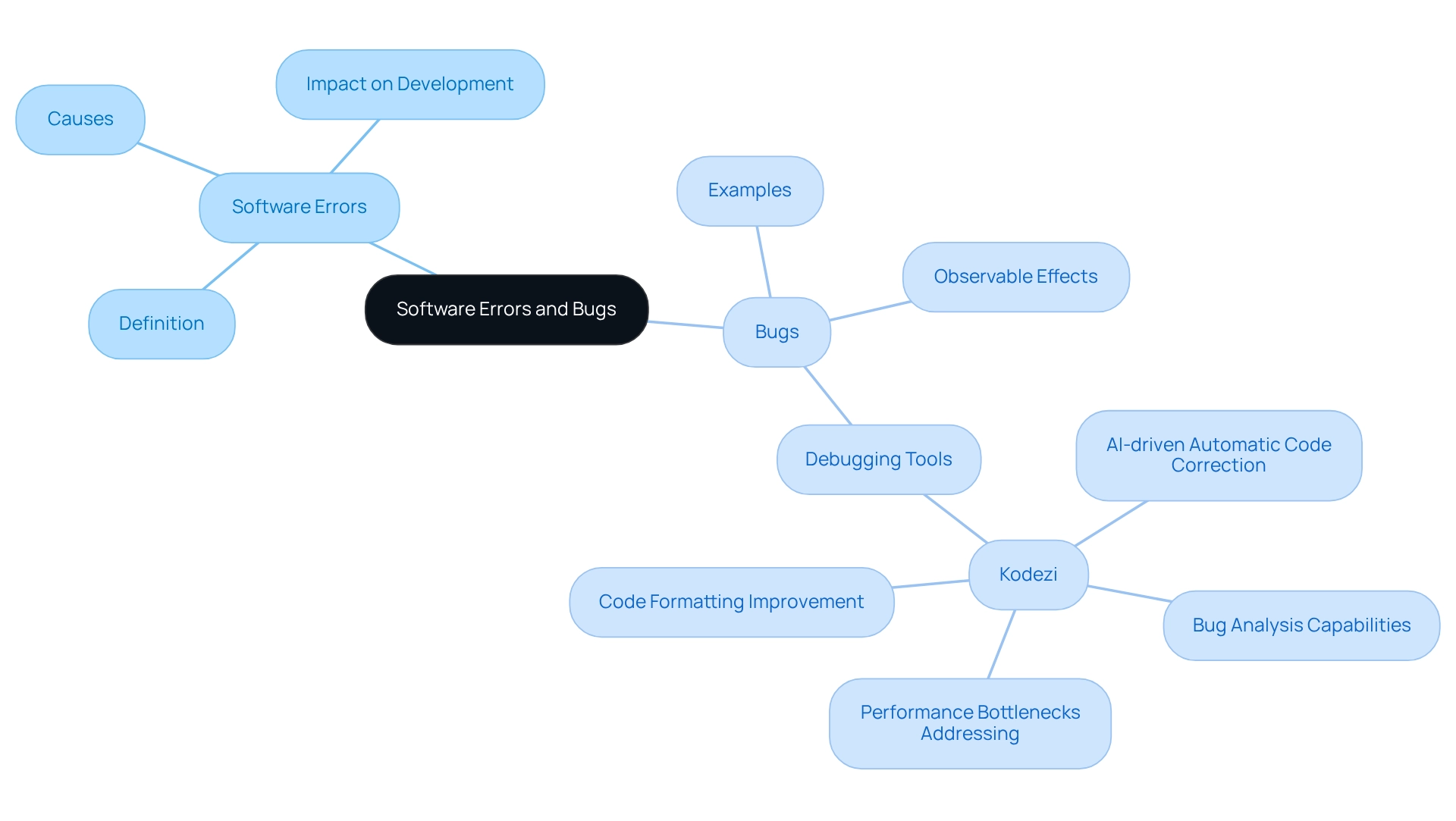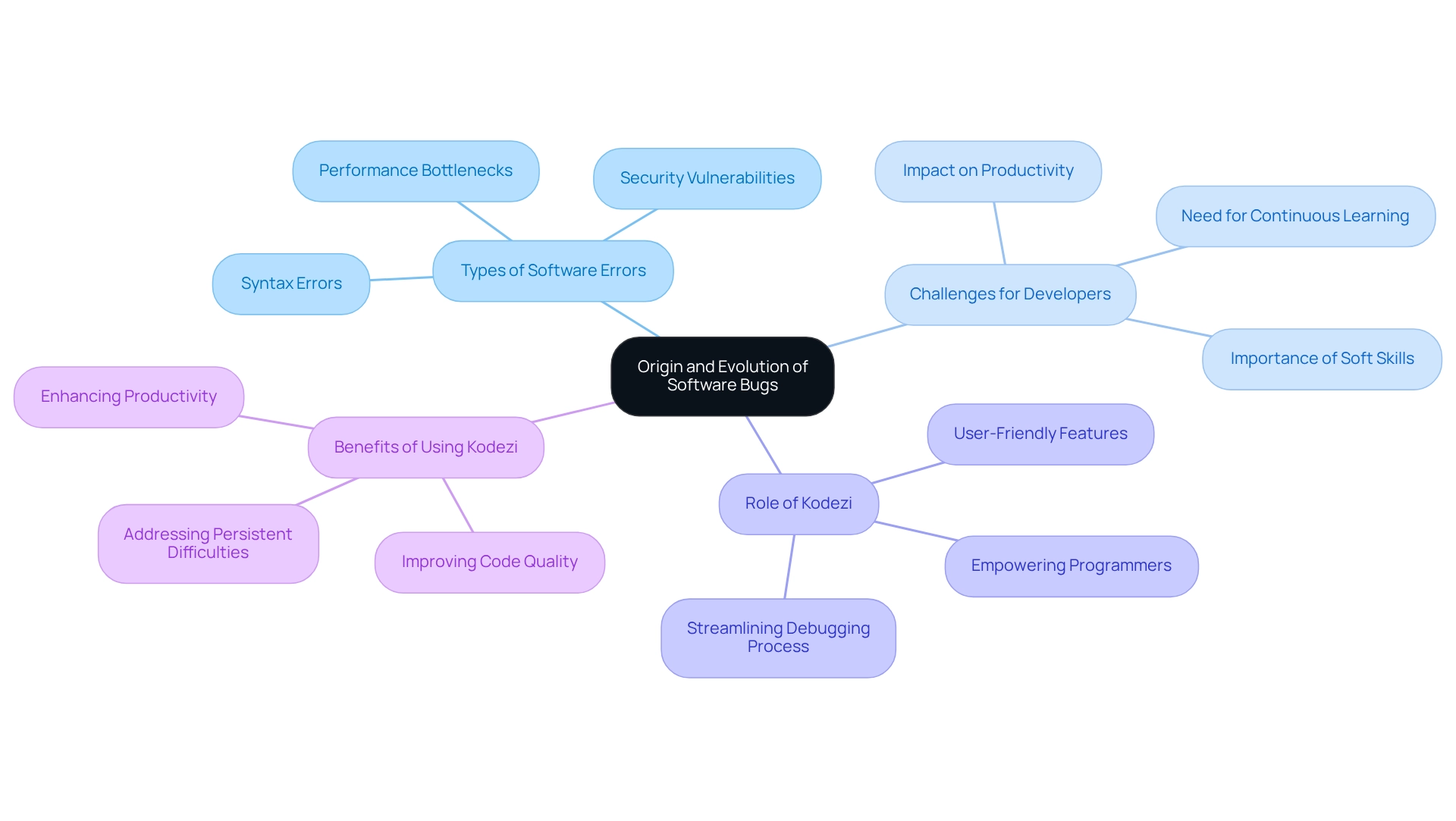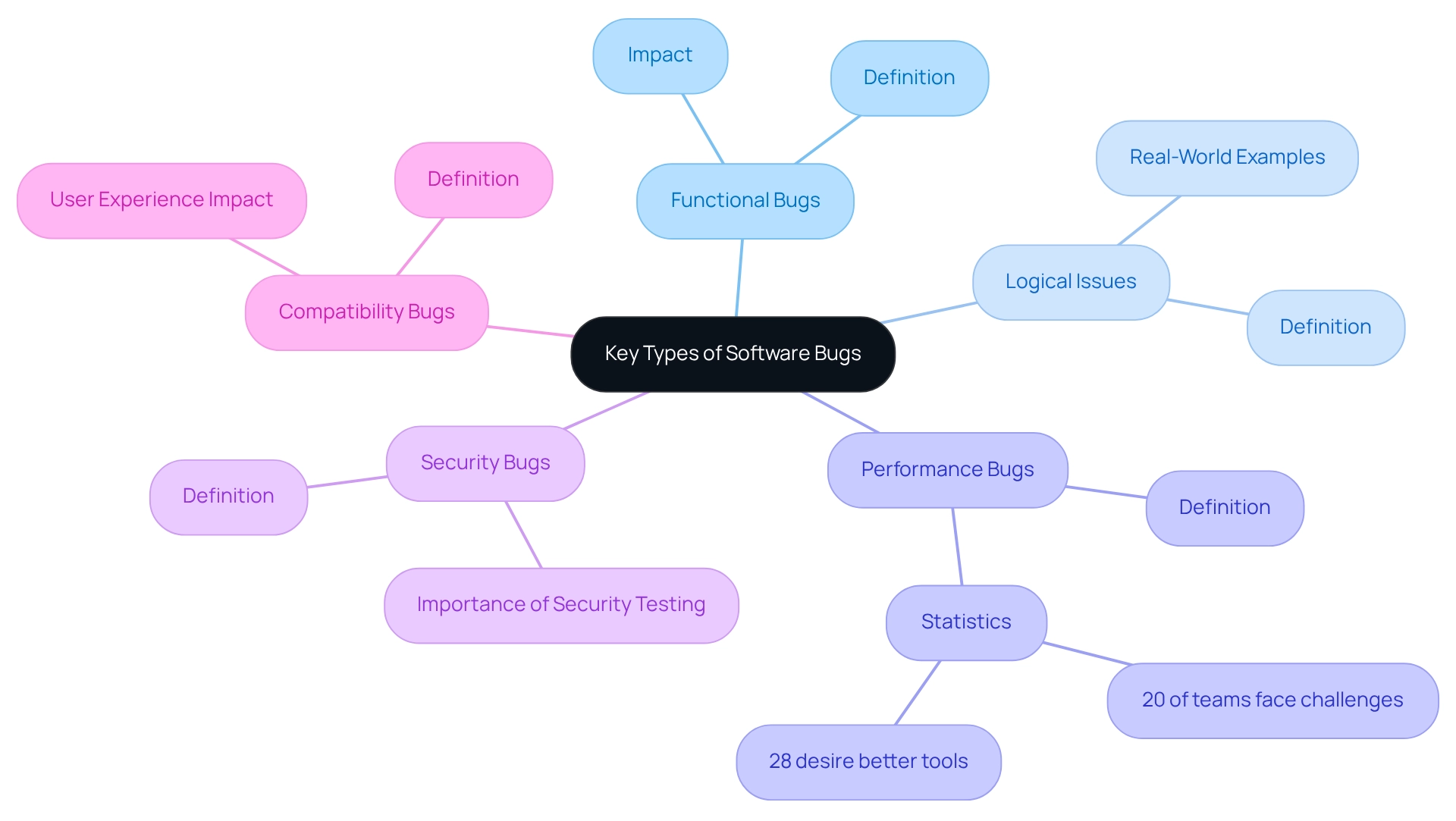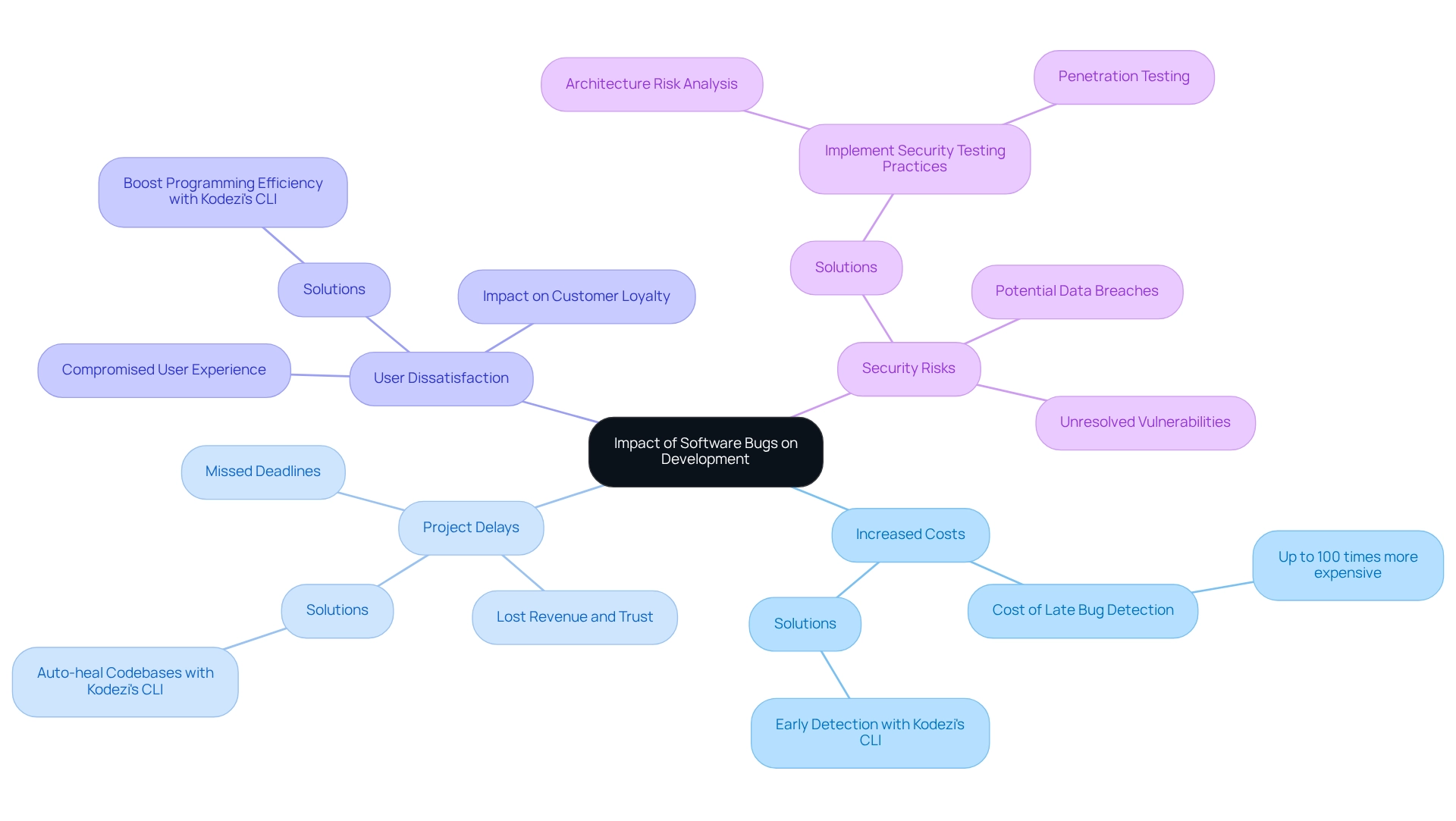Overview
The article highlights the significant challenges developers face with software errors and bugs. Understanding the distinction between software errors—essentially programmer mistakes—and observable bugs resulting from those errors is crucial. Various types of bugs, including functional, logical, performance, security, and compatibility issues, can greatly impact development. Furthermore, tools like Kodezi play a vital role in enhancing code quality and debugging efficiency.
How does Kodezi specifically address these challenges? By offering features designed to streamline the debugging process, Kodezi helps developers identify and rectify issues more effectively. This not only reduces the time spent on debugging but also fosters a more efficient coding environment.
The benefits of using Kodezi are clear. Improved productivity and enhanced code quality lead to more successful project outcomes. By utilizing Kodezi, developers can ensure that their coding practices are more efficient, ultimately resulting in higher-quality software.
Explore the tools available on the Kodezi platform today. Are you ready to elevate your coding experience? With Kodezi, you can tackle software errors and bugs head-on, transforming challenges into opportunities for growth.
Introduction
In the intricate world of software development, the battle against errors and bugs presents a constant challenge that can determine the success or failure of a project. This struggle is not merely a nuisance; it is a critical factor that developers must navigate. While the terms 'errors' and 'bugs' are often used interchangeably, understanding their distinctions is essential for those aiming to enhance code quality and streamline debugging processes. As software systems grow increasingly complex, it becomes vital to grasp the nature of bugs—from functional and logical to performance and security.
Furthermore, with a surge in reported software issues, the need for effective tools and strategies has never been more pressing. This is where Kodezi comes into play, offering innovative solutions designed to empower developers in tackling these challenges head-on. By providing specific features that address common pain points, Kodezi stands out as a valuable resource for improving productivity and code quality.
In addition, utilizing Kodezi not only streamlines the debugging process but also enhances overall efficiency. Imagine being able to identify and resolve issues more quickly, allowing for a smoother development experience. The benefits of using Kodezi are clear: improved productivity, enhanced code quality, and a more effective development workflow.
As you reflect on your coding practices, consider the tools available on the Kodezi platform. Explore how they can transform your approach to software development and help you overcome the challenges posed by bugs and errors. The journey toward better code starts with understanding and addressing these critical issues.
Define Software Errors and Bugs
In application development, developers frequently encounter challenges related to types of software errors and bugs. While these terms are often used interchangeably, they represent distinct concepts in the context of types of software errors and bugs. A software error is a mistake made by a programmer during the coding process, representing one of the types of software errors and bugs, which can lead to unintended behavior in the software. Bugs, on the other hand, are the observable manifestations of types of software errors and bugs, leading to incorrect outputs, crashes, or unexpected behavior during execution. Understanding this distinction is crucial for developers, as it aids in diagnosing types of software errors and bugs while implementing effective debugging strategies.
A case study titled 'Estimating Error Rates in Computational Programs' reveals that even conservative estimates suggest a substantial likelihood of erroneous results in applications. This emphasizes the necessity for rigorous validation and underscores the significance of grasping the differences between mistakes and defects, as it directly influences the quality of the applications developed.
Furthermore, the testing landscape is evolving. Organizations are increasingly seeking quicker and more effective solutions to address these issues. Specialists in the area highlight that understanding the distinctions between mistakes and faults is crucial for enhancing code quality and boosting productivity. For instance, the highest-performing engineers are 1.5 times more likely to utilize easy-to-use tools that facilitate this understanding. David Soergel emphasizes this point, stating, "I did really mean both things--I've tried to clarify that."
In addition, recognizing the difference between types of software errors and bugs not only aids in effective debugging but also aligns with recent trends in software development. The focus is on enhancing code quality and minimizing errors. Tools like Kodezi, with their AI-driven automatic code correction, bug analysis capabilities, and features such as addressing performance bottlenecks and improving code formatting, can play a significant role in this process. They provide developers with the resources needed to identify and resolve issues swiftly. The CLI of the platform guarantees that code quality is preserved by detecting and resolving issues prior to code deployment, thereby improving performance, security, and compliance with coding standards. Unlike competitors like Copilot, Kodezi focuses on being an autocorrect tool, allowing for a more proactive approach to debugging.
Are you ready to enhance your coding practices? Explore the tools available on Kodezi's platform to experience the benefits of improved productivity and code quality.

Explore the Origin and Evolution of Software Bugs
Coding challenges are an ever-present reality for developers, impacting productivity and code quality. With the evolution of computer systems, the nature of these challenges has expanded to encompass different types of software errors and bugs, from simple syntax errors to complex performance bottlenecks and security vulnerabilities. In this landscape, tools like Kodezi have emerged as essential resources for developers, helping them navigate these issues effectively.
Kodezi stands out by providing a platform that empowers programmers to locate and resolve bugs more quickly and efficiently. With over 1,000,000 users, it has been praised for its user-friendly features. Imagine a tool that feels like 'unlocking a new superpower' in debugging, as one user described it. Such capabilities not only streamline the debugging process but also enhance overall productivity within engineering teams.
The benefits of using Kodezi are clear: it aids in improving code quality while addressing the persistent difficulties programmers face. A significant 76% of programmers believe that managing these challenges requires a blend of current knowledge, adaptable methods, and effective communication. Furthermore, as the application outsourcing sector continues to grow, understanding how these tools connect to the historical context of types of software errors and bugs becomes increasingly vital. In conclusion, exploring the tools available on Kodezi can lead to significant efficiency gains in your coding practices. Are you ready to enhance your productivity and tackle coding challenges head-on? With Kodezi, you can transform your approach to debugging and elevate your programming experience.

Identify Key Types of Software Bugs
Program errors can be classified into several key types of software errors and bugs, each having distinct characteristics that impact application performance and reliability. Understanding the types of software errors and bugs is crucial for developers aiming to enhance their debugging and testing strategies. The primary categories consist of:
- Functional Bugs: These arise when the application fails to execute its intended function, often resulting from incorrect requirements or specifications. A considerable portion of application projects are influenced by functional issues, emphasizing the necessity for thorough requirement assessment.
- Logical Issues: These stem from mistakes in the program's logic, leading to incorrect results even when the code runs without syntax errors. Real-world instances demonstrate how logical errors can result in considerable operational problems, requiring comprehensive testing to pinpoint and address them.
- Performance Bugs: These affect the speed and efficiency of the application, often appearing as slow response times or excessive resource usage. According to Docker's 2024 State of Application Development Report, 20% of software development teams reported challenges during debugging and testing phases, underscoring the importance of addressing performance-related issues. The automated code debugging feature enables programmers to resolve performance bottlenecks rapidly, ensuring that applications operate efficiently and comply with the latest coding standards. Additionally, the report indicates that 28% of respondents expressed a desire for better tools in these areas, emphasizing the need for enhanced testing and debugging tools.
- Security Bugs: These vulnerabilities can be exploited by malicious actors, potentially leading to data breaches or unauthorized access. The urgency of addressing security issues is heightened by the growing frequency of cyber threats, making it crucial for programmers to prioritize security testing. Kodezi guarantees that codebases adhere to the most recent security best practices, assisting programmers in detecting and addressing security problems promptly.
- Compatibility Bugs: These arise when applications do not function properly across diverse environments or platforms, such as differing operating systems or browsers. Ensuring compatibility is crucial for providing a flawless user experience across various systems, as it helps in identifying types of software errors and bugs; by classifying these issues, developers can better prioritize their troubleshooting efforts and apply more efficient testing strategies, ultimately resulting in enhanced quality and productivity.

Assess the Impact of Software Bugs on Development
The effect of various types of software errors and bugs on development is considerable, impacting not only the immediate performance of applications but also the entire project lifecycle. Developers often face significant challenges due to various types of software errors and bugs, which can lead to several critical issues.
- Increased Costs: Addressing bugs later in the development process can be exponentially more expensive than resolving them early. Research indicates that fixing a bug can cost up to 100 times more if detected late in the software development lifecycle. This underscores the importance of early detection and resolution of types of software errors and bugs to minimize financial impacts. Kodezi's CLI functions as a self-sufficient tool that assists B2B engineering teams in detecting and resolving issues prior to production, greatly lowering these expenses. For teams aiming to start rapidly, this platform provides a '5 minute quickstart' and an opportunity to 'See a demo' to showcase its functionalities.
- Project Delays: Bugs can impede development progress, resulting in missed deadlines and prolonged project timelines. Such delays can lead to lost revenue and eroded stakeholder trust, as projects extend beyond their expected completion dates. By utilizing Kodezi's CLI, teams can quickly auto-heal codebases, thereby maintaining momentum and adhering to project schedules.
- User dissatisfaction can be caused by types of software errors and bugs that compromise user experience, leading to frustration and potentially damaging a company's reputation and customer loyalty. The financial effect of these types of software errors and bugs can be significant, as user retention is closely linked to system reliability. Kodezi's CLI tool boosts programming efficiency, enabling teams to provide more dependable applications and enhance user satisfaction. For instance, a team that utilizes the CLI may observe a decrease in user-reported problems, resulting in improved retention rates.
- Security Risks: Unresolved security vulnerabilities can expose systems to significant risks, including data breaches that may incur hefty financial and reputational costs. Implementing security testing practices, such as architecture risk analysis and penetration testing, as outlined in the case study "Security Testing Practices to Reduce Bug Fix Costs," can help identify and mitigate these risks early in the development process. Kodezi CLI incorporates these practices into its workflow, aiding a larger strategy to reduce bug fixing expenses and improve overall quality.
By acknowledging these effects, developers and project leaders can prioritize the resolution of various types of software errors and bugs, and implement more efficient quality assurance strategies, ultimately improving product quality and resilience. Furthermore, considering industry averages can provide further context on the financial impact of bugs, reinforcing the need for proactive measures in software development.

Conclusion
Navigating the complexities of software errors and bugs is essential for developers striving to improve code quality and optimize their debugging processes. Understanding the difference between errors—coding mistakes—and bugs, which are the visible outcomes of those errors, is vital for diagnosing problems and implementing effective solutions. The progression of software bugs, from basic syntax errors to intricate performance and security vulnerabilities, highlights the imperative for developers to remain informed and adaptable in their approaches.
Furthermore, recognizing the different types of software bugs—functional, logical, performance-related, security, and compatibility—enables developers to prioritize their debugging efforts effectively. With the right tools, such as Kodezi, these challenges can be tackled proactively, enhancing productivity and overall software quality. Kodezi's innovative features support swift identification and resolution of issues, enabling teams to maintain momentum and adhere to project timelines.
In addition, the ramifications of software bugs extend beyond immediate functionality, affecting project costs, timelines, user satisfaction, and security. By emphasizing early detection and resolution, developers can mitigate these risks, ensuring a smoother development process and fostering trust among stakeholders. As the software landscape continues to evolve, utilizing tools like Kodezi empowers developers to navigate these challenges successfully, leading to more reliable and resilient software solutions.
Frequently Asked Questions
What is the difference between a software error and a bug?
A software error is a mistake made by a programmer during the coding process, which can lead to unintended behavior in the software. A bug, on the other hand, is the observable manifestation of a software error, resulting in incorrect outputs, crashes, or unexpected behavior during execution.
Why is it important for developers to understand the distinction between errors and bugs?
Understanding the distinction between errors and bugs is crucial for developers as it aids in diagnosing issues and implementing effective debugging strategies, ultimately enhancing code quality and productivity.
What does the case study "Estimating Error Rates in Computational Programs" reveal?
The case study reveals that even conservative estimates suggest a substantial likelihood of erroneous results in applications, emphasizing the necessity for rigorous validation and the importance of grasping the differences between mistakes and defects.
How are organizations adapting to the challenges of software errors and bugs?
Organizations are increasingly seeking quicker and more effective solutions to address software errors and bugs, focusing on enhancing code quality and minimizing errors.
What role do tools like Kodezi play in addressing software errors and bugs?
Tools like Kodezi provide AI-driven automatic code correction, bug analysis, and features that address performance bottlenecks and improve code formatting, helping developers identify and resolve issues swiftly while preserving code quality prior to deployment.
How does Kodezi differ from competitors like Copilot?
Unlike competitors like Copilot, Kodezi focuses on being an autocorrect tool, allowing for a more proactive approach to debugging rather than just providing suggestions.




